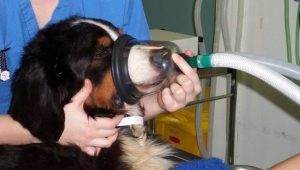ADV- Lesson 2- Respiration and Ventilation

The primary organs of the respiratory system are the lungs, which function to take in oxygen and expel carbon dioxide as we breathe. The human respiratory system is a series of organs responsible for taking in oxygen and expelling carbon dioxide.
As an animal inhales, fresh air moves through the nose (or mouth), pharynx, and larynx to the trachea. The trachea carries the air to the bronchi, which in turn supply the lungs. Air exchange occurs in the alveoli and the used air follows the opposite path of new air: passing into the bronchi, into the trachea, through the larynx and pharynx, and finally exiting through the nose or mouth.
Breathing is relatively simple and is accomplished by the actions of the rib muscles (intercostals) and the movement of a great internal muscle called the diaphragm. The diaphragm muscle separates the chest, containing the heart and lungs, from the abdomen which holds the intestines, stomach, liver, bladder, etc. As this great muscle moves toward the abdomen, it creates a negative pressure and pulls fresh air and oxygen into the lungs, causing the dog to breathe in (inhale). The chest cavity surrounding the lungs is a vacuum, thus allowing the lungs to inflate easily when the dog inhales. When the muscle moves forward (towards the animal’s head), it causes the lungs to compress and force air out (exhale), thus ridding the body of used air. Foster DVM, Race. “Respiratory System: Anatomy & Function in Dogs.” Pet Education. N.p., n.d. Web. 23 Jan. 2017.
The nose (along with the mouth) is responsible for taking air into the body. Both the fine hairs (cilia) that line the nasal cavity and the mucus that is produced by the cells of the nasal cavity work to filter debris and foreign material from the air before it enters the body. The nasal cavity also warms and moistens the air before it enters the trachea. The blood supply to this area is extensive and contributes to warming the inspired air. Moisture is added to the air by the evaporation of mucosal secretions. As air passes over the back portion of the nose, the sense of smell is activated.
The nasopharynx functions as the passageway between the nasal cavity and the larynx. Air transported through this area passes very near the tonsils. The tonsils are a part of the immunologic system and can activate certain defense mechanisms of the body when foreign material and infectious agents are detected. The larynx guards the entrance to the trachea and regulates both the inspiration and expiration of air. The valvular function of the larynx, which is created by the epiglottis and arytenoid cartilages, is vital to protecting the airway and to prevent the aspiration of food. The larynx also contains the vocal folds, which are necessary for vocalization, such as barking, whining, and growling.
The trachea or windpipe serves to conduct air downward into the lungs. It is also lined by tiny hairs called cilia and mucus producing cells that trap debris and foreign substances. The trachea returns those substances to the mouth through the act of coughing. The bronchi bring air from the trachea into the lungs. Like the trachea they are also lined with cilia and mucus producing cells.
The main function of the lungs is to provide a huge surface area over which gases are exchanged between the body’s circulation and the outside air. Oxygen is taken in from the atmosphere and carbon dioxide is exhaled from the blood. The physical act of breathing involves well-coordinated interactions between the lungs, the central nervous system, the diaphragm, and the circulatory system.
There are two primary respiratory functions, ventilation, and oxygenation. [7] Minute Ventilation or minute volume is the volume of gas inhaled (inhaled minute volume) or exhaled (exhaled minute volume) from an animal’s lungs per minute. If both tidal volume (VT) and respiratory rate (RR) are known, minute volume can be calculated by multiplying the two values. Minute Ventilation= Tidal Volume x Respiratory Rate.
Establishing an Airway
Unconscious, apneic animals require immediate tracheal intubation. The clinician should be practiced in orotracheal intubation of animals in dorsal, lateral, and sternal recumbency. If an obstruction is present, it must be immediately relieved (with suction, manual removal, or the Heimlich maneuver) or bypassed via emergency tracheotomy. Once an airway is established, confirmed, and secured, ventilation is initiated with 100% oxygen via a bag-valve-mask. Should auscultation during ventilation detect absent or muffled lung sounds indicative of pleural fluid or air, immediate thoracocentesis is warranted.
A transtracheal catheter can be used to provide oxygen support during stabilization. When the airway pathology lies within the thoracic cavity, airway patency must be established down to the bifurcation of the trachea. Once the airway is established, it should be secured with a tie and inflation of the cuff mechanism to a maximum of 20 mmHg.
Once the airway is secured, intubation should be confirmed with at least two of the following methods:
-
palpation of the tube within the trachea (only one “tube” palpated in cervical region)
-
bilateral auscultation of the lungs
-
visualization of chest wall movement with manual ventilation
-
visualization of the tube entering the airway
-
placement of end-tidal CO2 monitor (normal is 35–45 mmHg)
-
radiographs
